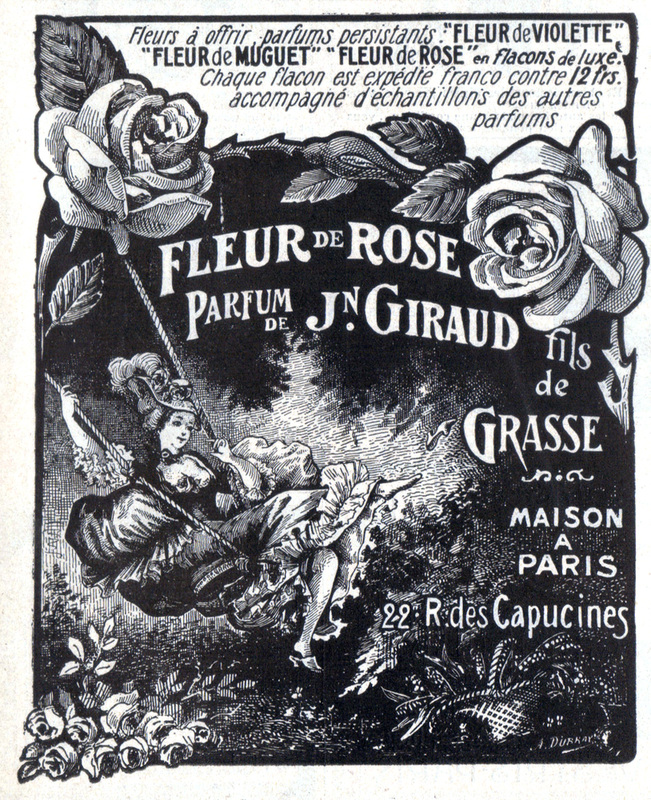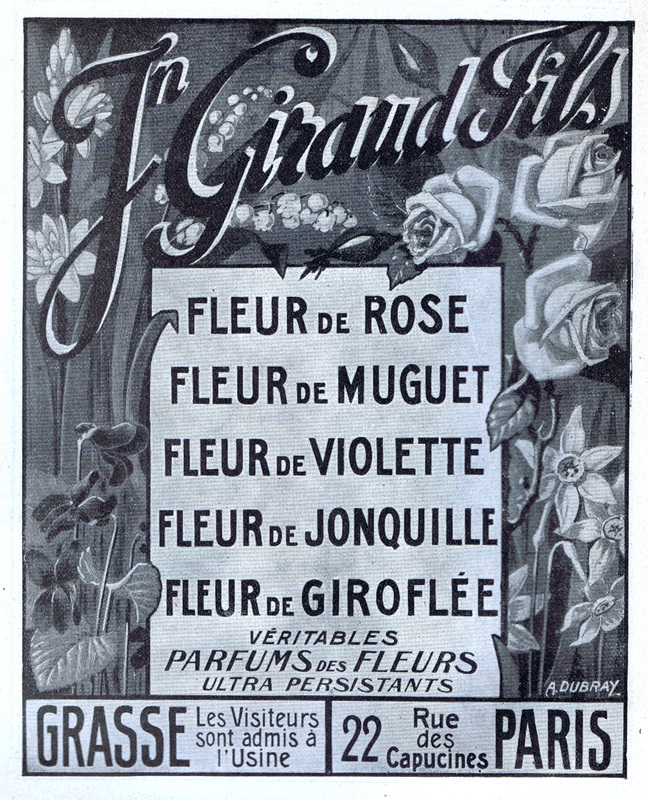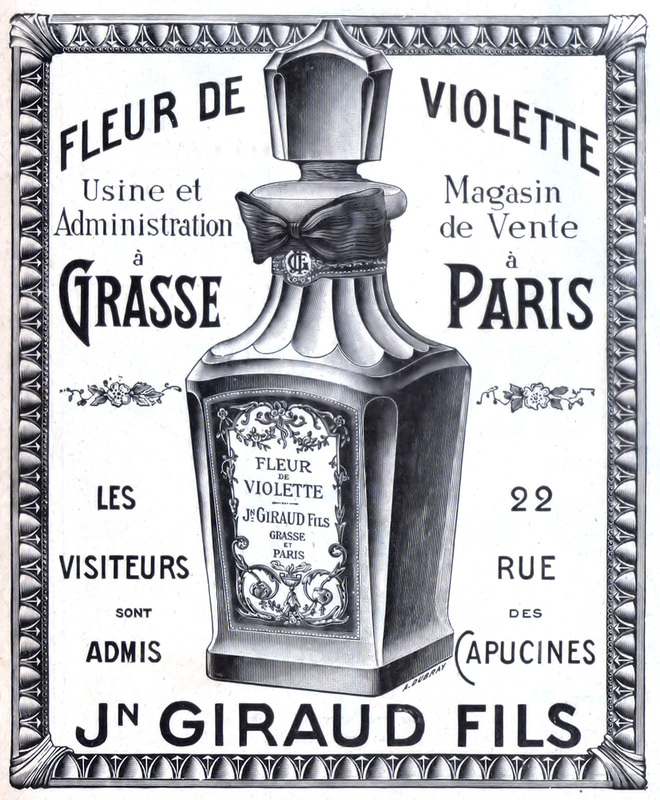Jean Giraud et Fils, originally founded in 1853 as Giraud Frères, underwent several transformations before becoming known as J. Giraud Fils in 1900. This change followed its acquisition by prominent essential oils producers in Grasse, including Honoré Joseph Sozio. Renowned for its extensive export network, the company reached markets across South America, establishing a strong international presence. Under the branding of "Principle of Flowers," Jean Giraud et Fils offered a diverse range of products that highlighted the rich heritage and expertise of its perfumery and essential oil operations.

c1910
Jean-Paul Giraud et Fils, a renowned perfumery house, introduced a distinguished collection of fragrances over several decades, each reflecting their commitment to quality and olfactory innovation.
In 1890, the house launched Essence Concentrée L'Iris Blanc (Concentrated Essence of White Iris) and Lavande des Alpes (Lavender from the Alps). The former likely featured the delicate, powdery notes of white iris, offering a sophisticated floral aroma. Lavande des Alpes probably captured the crisp, fresh scent of alpine lavender, with its soothing and herbal qualities.
By 1900, they expanded their range with Eau de Cologne Ambrée (Amber Cologne), an oriental fragrance that likely exuded warm, resinous amber notes combined with the freshness of a classic cologne.
In 1906, Jean-Paul Giraud et Fils introduced a series of perfumes including Parfum Rêvé (Dream Perfume), which might have been an ethereal blend of light, dreamy florals; Fleur de Lavande (Lavender Flower), likely featuring a rich, aromatic lavender scent; Fleur de Muguet (Lily of the Valley Flower), known for its fresh, sweet, and green floral notes; Fleur de Violette (Violet Flower), which probably offered a soft, powdery violet aroma; Fleurs de Rose (Rose Flowers), likely capturing the classic, luxurious scent of fresh roses; Genêt de Estérel (Gorse of Estérel), which might have presented the warm, slightly sweet scent of gorse flowers; and Rosat-Genium, which could have been a complex, rosy fragrance with a hint of exotic spices.
In 1910, the releases included Fleur de Jonquille (Daffodil Flower) and Fleur de Giroflee (Clove Flower). Fleur de Jonquille might have featured the bright, sunny aroma of daffodils, while Fleur de Giroflee likely offered a spicy, warm clove scent.
The following years brought Fleur Mimosa (Mimosa Flower) in 1911, known for its light, fluffy, and slightly powdery fragrance; and Dans les Nues (In the Clouds) in 1912, which could have been a dreamy, airy scent with a blend of soft florals.
The year 1916 was particularly noteworthy with the introduction of several notable scents. White Lilac (Lilas Blanc) likely evoked the delicate, sweet aroma of lilacs; White Rose (Rose Blanc) offered a fresh, elegant rose scent; Musc featured the warm, sensual notes of musk; La Riviera probably captured the breezy, citrusy essence of the Mediterranean coast; Le Jasmin (Jasmine) exuded the rich, intoxicating scent of jasmine; Ess. Bouquet (Bouquet Essence) might have been a complex blend of various floral notes; Mt. Blanc Bouquet (Mont Blanc Bouquet) could have evoked the fresh, crisp scents of alpine flora; and Ylang Ylang, known for its rich, exotic floral fragrance with a hint of sweetness.
Jean-Paul Giraud et Fils continued to impress with Bouquet Egyptien (Egyptian Bouquet) in 1917, likely an exotic blend of floral and spicy notes reminiscent of the rich scents of ancient Egypt; Mariana in 1918, which could have been a soft, floral scent; Le Cyclamen (Cyclamen) in 1919, known for its sweet, powdery floral aroma; and Veraflor in the same year, likely a refined, elegant floral blend.
Jean-Paul Giraud et Fils, known for their sophisticated perfume offerings, launched a series of evocative fragrances across the early 20th century. Each perfume, imbued with a rich blend of olfactory artistry, is named to evoke specific imagery and emotion.
In 1920, Aux Fleurs de Jasmin, which translates to "With Jasmine Flowers," likely captured the luxuriant, intoxicating scent of jasmine in full bloom. This perfume would have been a celebration of jasmine’s rich, sweet aroma, potentially blended with other delicate florals to create a lush, opulent fragrance.
Eau de Cologne Supérieure, also from 1920, translates to "Superior Cologne Water." This fragrance would have offered a classic, refined cologne experience, featuring crisp citrus notes balanced with fresh, herbal elements typical of high-quality colognes.
Eau de Rose Concentrée, meaning "Concentrated Rose Water," would have been an intense and luxurious rose fragrance. This perfume likely concentrated the rich, velvety scent of rose petals into a powerful, elegant essence.
Folavril and Frago, both launched in 1920, have more ambiguous names. Folavril could suggest a floral or spring-like fragrance, possibly with hints of freshness reminiscent of April’s renewal. Frago might imply a unique blend of floral and fruity notes, with a distinctive character.
Les Fleurs de Nice, translating to "The Flowers of Nice," from 1920, likely featured a bouquet of flowers native to the French Riviera, such as roses, jasmine, and lavender, reflecting the sunny and delicate nature of the region.
Madapril and Mystèriose, also from 1920, evoke a sense of allure and sophistication. Madapril might combine floral freshness with a touch of April’s vibrant spirit, while Mystèriose—meaning "Mysterious"—likely offered a complex, enigmatic blend of exotic and intriguing notes.
Japtis Parfum and Idilio, from 1920, hint at distinctive and possibly exotic fragrances. Japtis could suggest influences from Japanese or exotic elements, while Idilio, translating to "Idyll," might evoke a romantic and dreamy scent experience.
Odorantis and Parfum Cassiris, also from 1920, suggest intriguing olfactory profiles. Odorantis, meaning "Odoriferous," would have a strong, pleasant aroma, possibly featuring floral or spicy notes. Parfum Cassiris might offer a sophisticated, richly layered scent.
In 1922, L’Ambré, meaning "The Amber," would present a warm, resinous fragrance with rich amber notes, possibly enhanced with spices and woods to create a deep, captivating scent.
La Rose and La Violette, from the same year, translate to "The Rose" and "The Violet." La Rose would focus on the classic, elegant scent of roses, while La Violette would highlight the soft, powdery aroma of violets.
Le Chypre, also from 1922, refers to the classic Chypre fragrance family, known for its sophisticated blend of citrus, oakmoss, and patchouli. This perfume would offer a refined, earthy scent profile.
Le Cougourdon Provencia, meaning "The Pumpkin of Provence," suggests a unique blend that might combine the earthy sweetness of pumpkin with Provencal herbs and flowers, creating an aromatic and intriguing fragrance.
Royal Bouquet, from 1922, implies an opulent and regal fragrance, featuring a rich floral bouquet crafted with luxurious blooms, designed to evoke a sense of royalty and grandeur.
En Nue, translating to "In the Nude," suggests a subtle, understated fragrance with a soft, skin-like scent that is both elegant and unobtrusive.
Lysmina, from 1922, combines "Lys" (Lily) with a suffix indicating refinement. This fragrance likely features a delicate and elegant lily scent. L’Œillet, meaning "The Carnation," also from 1922, would showcase the spicy, floral notes of carnations, adding a vintage touch to the collection.
In 1923, Maflor likely suggests a floral fragrance with exotic or lush notes, offering a rich and multi-layered scent experience.
Brisolia, from 1926, might evoke a fresh and invigorating scent, potentially incorporating bright citrus or herbal elements for a lively and refreshing profile. La Soirée, from 1926, translates to "The Evening," suggesting a sophisticated fragrance designed for evening wear, with warmer, sensual notes.
Saga-Zain, from 1927, is less clear but might suggest an exotic or narrative-driven scent with rich, historical, or cultural elements.
In 1932, Fils Orana and Orana translate to "Child of Orana" and "Orana" respectively. These names suggest refined and elegant fragrances with a touch of heritage or personal significance, possibly offering a nuanced and sophisticated olfactory experience.
Au Muguet des Alpés, which translates to "The Lily of the Alps," likely embodies the fresh, delicate aroma of lily of the valley, evoking the crisp, floral essence found in the alpine regions. This perfume would have offered a light, ethereal fragrance, reminiscent of a serene alpine spring.
Bandoline aux Fleurs, meaning "Bandoline with Flowers," was designed as a hair groom. Bandoline, a traditional hair styling product, would have been enhanced with floral notes, providing a sophisticated blend of fragrances such as rose, jasmine, or violet, creating a refined and elegant scent suitable for personal grooming.
Blanch suggests a clean, pure fragrance, perhaps focusing on fresh, white floral notes or a crisp, soapy clean scent. This perfume likely exuded a sense of simplicity and clarity, ideal for a refreshing and understated aroma.
Cattleya, named after the exotic orchid genus, would have captured the lush, sophisticated scent of the Cattleya orchid. This perfume likely featured rich, floral notes with a hint of tropical elegance, creating an opulent and captivating fragrance.
Cuir de Russe, translating to "Russian Leather," evokes the rich, warm, and somewhat smoky aroma of high-quality leather, reminiscent of traditional Russian leather goods. This scent would likely blend the deep, robust notes of leather with subtle undertones of spices and woods, offering a complex and luxurious fragrance.
Cupidon, named after the Roman god of love, suggests a romantic and enchanting scent. This perfume might have combined floral and fruity notes with a touch of sweetness, creating a charming and alluring fragrance that evokes the passion associated with Cupid.
Eau de Toilette aux Violettes d'Italie, meaning "Toilet Water with Italian Violets," would highlight the soft, powdery aroma of Italian violets. This fragrance likely offered a delicate and sophisticated profile, with the sweet, floral notes of violets capturing the essence of Italian elegance.
Elder Flower Water, as the name suggests, would feature the delicate, floral aroma of elderflower. Known for its light, sweet scent with hints of fruitiness, this perfume would have offered a refreshing and gentle fragrance, ideal for those who appreciate subtle floral notes.
Enticing Perfumes likely represents a collection or range of fragrances designed to captivate and allure. This name suggests a blend of intriguing and seductive scents, possibly combining various floral, fruity, and spicy notes to create an engaging and multifaceted perfume.
Floretta conveys a sense of delicate floral beauty. This perfume would likely feature a bouquet of soft, elegant flowers, creating a graceful and charming fragrance.
Fougère en France, meaning "Fern in France," evokes the classic fougère fragrance family, characterized by a blend of fresh herbs, woody notes, and a touch of sweetness. This scent would likely offer a refined and sophisticated profile, combining green, aromatic notes with a hint of earthy depth.
Rencontre, translating to "Encounter," suggests a fragrance designed to leave a memorable impression. This perfume might feature a complex blend of notes, combining floral, woody, and spicy elements to create a scent that is both intriguing and unforgettable.
Rodoll is less clear in its translation but could imply a unique or distinctive fragrance. The name suggests a scent that might blend various aromatic elements to create a signature, individual perfume.
Vridiflor Fougère likely combines the elements of a classic fougère with additional floral notes. The name suggests a fragrance that balances the fresh, green notes of fougère with the softness and complexity of florals, creating a harmonious and elegant scent.
These perfumes, with their evocative names and rich aromatic profiles, reflect the creative and diverse approaches of Jean-Paul Giraud et Fils to early 20th-century perfumery. Each was a testament to the brand’s dedication to creating evocative and memorable scents.
The perfumes of Giraud et Fils:
- 1890 Essence Concentrée L'Iris Blanc
- 1890 Lavande des Alpes
- 1900 Eau de Cologne Ambrée (an oriental fragrance)
- 1906 Parfum Rêvé
- 1906 Fleur de Lavande
- 1906 Fleur de Muguet
- 1906 Fleur de Violette
- 1906 Fleurs de Rose
- 1906 Genêt de Estérel
- 1906 Rosat-Genium
- 1910 Fleur de Jonquille
- 1910 Fleur de Giroflee
- 1911 Fleur Mimosa
- 1912 Dans les Nues
- 1916 White Lilac (Lilas Blanc)
- 1916 White Rose (Rose Blanc)
- 1916 Musc
- 1916 La Riviera
- 1916 Le Jasmin
- 1916 Ess. Bouquet
- 1916 Mt. Blanc Bouquet
- 1916 Ylang Ylang
- 1917 Bouquet Egyptien
- 1918 Mariana
- 1919 Le Cyclamen
- 1919 Veraflor
- 1920 Aux Fleurs de Jasmin
- 1920 Eau de Cologne Supérieure
- 1920 Eau de Rose Concentrée
- 1920 Folavril
- 1920 Frago
- 1920 Les Fleurs de Nice
- 1920 Madapril
- 1920 Mystèriose
- 1920 Japtis Parfum
- 1920 Idilio
- 1920 Odorantis
- 1920 Parfum Cassiris
- 1922 L’Ambré
- 1922 La Rose
- 1922 La Violette
- 1922 Le Chypre
- 1922 Le Cougourdon Provencia
- 1922 Royal Bouquet
- 1922 En Nue
- 1922 Lysmina
- 1922 L’Œillet
- 1923 Maflor
- 1926 Brisolia
- 1926 La Soirée
- 1927 Saga-Zain
- 1932 Fils Orana
- 1932 Orana
- Au Muguet des Alpés
- Bandoline aux Fleurs (hair groom)
- Blanch
- Cattleya
- Cuir de Russe
- Cupidon
- Eau de Toilette aux Violettes d'Italie
- Elder Flower Water
- Enticing Perfumes
- Floretta
- Fougère en France
- Rencontre
- Rodoll
- Vridiflor Fougère
Chemist and Druggist, 1889:
"The essential oils and pomades of M. Jean Giraud Fils of Grasse are not unfamiliar in the English markets or in Australasia the firm having been awarded a high distinction at last year's Melbourne Exhibition. In Paris also, M. Giraud Fils has a tasteful and rich exhibit not only of raw products but likewise of prepared toilet waters, eau de Cologne, and other put up goods, in fact, when the firm was first established some thirty two years ago, its business, we believe, was that of manufacturing perfumers, and the distilling business, which now appears to be the principal branch, was afterwards added to it. Now, the establishment at Grasse is stated to be fitted with all the newest distilling and pressing machinery, and with a freezing apparatus by means of which, extracts by subjecting them to a very low temperature, are freed from any adhering fatty parts, which would render them cloudy in a cold climate. The distillation of scented woods, and the preparation of sachet powders also fall within the scope of M. Giraud's business, and we understand that all the cases in which his goods are exported are manufactured on the premises of the firm.
In an 1889 issue of Chemist and Druggist, the expertise and innovation of M. Jean Giraud Fils of Grasse are highlighted, showcasing their prominence in the world of perfumery and essential oils. The article notes that the firm's products, particularly their essential oils and pomades, have already established a strong presence in both English markets and Australasia. This reputation was further solidified when the company was awarded a prestigious distinction at the Melbourne Exhibition the previous year, underscoring their international acclaim.
M. Giraud Fils also made a significant impact in Paris, where they exhibited an impressive and aesthetically pleasing display. This exhibit featured not only raw materials but also a variety of prepared goods, including toilet waters, eau de Cologne, and other refined products. The firm's history, dating back thirty-two years at the time, began with a focus on manufacturing perfumes. However, as the business evolved, the distillation of essential oils became a central aspect of their operations.
The establishment at Grasse is described as being equipped with the latest advancements in distillation and pressing machinery, reflecting the firm's commitment to innovation. A notable feature of their production process is the use of a freezing apparatus, which allows for the purification of extracts by removing any fatty residues that could cause cloudiness in colder climates. This attention to detail ensures that their products maintain the highest quality standards, even when exported to regions with varying temperatures.
Additionally, M. Giraud's business encompasses the distillation of scented woods and the preparation of sachet powders, demonstrating the firm's versatility within the perfumery industry. The company takes great pride in the fact that all the cases used for exporting their goods are manufactured in-house, further emphasizing their dedication to craftsmanship and quality control. This comprehensive approach to production and exportation underscores the firm's status as a leader in the perfumery world.

c1910














No comments:
Post a Comment
All comments will be subject to approval by a moderator. Comments may fail to be approved if the moderator deems that they:
--contain unsolicited advertisements ("spam")
--are unrelated to the subject matter of the post or of subsequent approved comments
--contain personal attacks or abusive/gratuitously offensive language